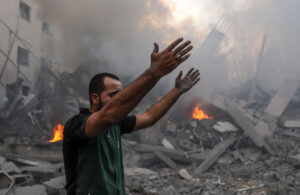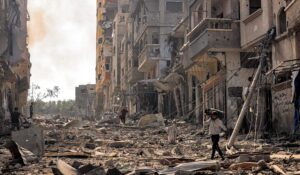When conventional armies take on enemies who have neither uniforms nor overt bases, and who impolitely refuse to assemble in conveniently targetable mass formations, the inevitable problem is how to find them. Indeed, such a task is often impossible, a reality that otherwise intelligent tacticians have mysteriously refused to accept, from Napoleon in Spain to the US in Afghanistan.
In all their wars, that is the one error the Israelis have never made, and they are not about to start now. Aside from the Fauda teams before they defected to Netflix, and the undercover Shin Bet agents who can track down individual leaders, the Israelis have been content to remain on the defensive. Any offensive actions are taken only against clear enemies in recognisable garb, even if not actual uniforms, as well as physical facilities that can be spotted from the air, such as the recently destroyed Iranian rocket depots in Damascus and Aleppo.
In Gaza, by contrast, there are no visible military facilities, while Hamas fighters can shed their fashionable black outfits and dress like civilians. This will not, however, frustrate the Israeli offensive, which still has fixed, immovable targets. These are the deep tunnels — too deep for aerial bombing — that Hamas has been excavating and lining in concrete for more than 10 years, using construction equipment and vast quantities of cement donated by different governments and international organisations “to house refugees”. As a result, Gaza’s refugee “camps” do not contain a single tent. Instead, they are home to a forest of high-rise apartments, which is undoubtedly a good thing, except for the fact that both machines and cement were also diverted for tunnelling on the largest scale.
These tunnels house relatively sophisticated rocket-assembly lines, motor-assembly works, sheet metal and explosives’ stores, and warhead-fabrication workshops. More tunnels house Hamas command posts and its ordnance stores of small arms, mortars and rockets. Even deeper tunnels house its leaders’ lodgings and headquarters. Finally, there are the exfiltration tunnels, though there is no sign that they were used in the October 7 attacks, perhaps because their exits had been detected and blocked long before.
When Israel’s forces enter Gaza, they will engage any enemies who resist them, but they will not go looking for them. Their task is to escort combat engineers to their job sites — the camouflaged places from which tunnels can be accessed. How do they know where these entry points are? While Israel’s aerostats with cameras, satellite photography and the pictures generated by radar returns cannot reveal tunnels, they have been used to monitor where cement-mixer trucks have stopped over the years. They cannot pinpoint tunnel entrances by doing so, but they can at least identify places worth exploring with low-frequency, earth-penetrating radars or simple probes.
The obvious danger here is that, even before the escorting troops and combat engineers descend underground to fight off Hamas’s guards and place their demolition charges, they will keep losing casualties to snipers and mortar bombs on their way to the sites.
To minimise the danger, however, the Israeli army can rely on the most heavily protected armoured vehicle ever developed: the Namer infantry combat vehicle. As well as having significantly more armour than any other combat vehicle anywhere in the world, it uses an active defence weapon to intercept incoming anti-tank missiles and rockets, and also has machine guns to fight off infantry attackers. In urban combat, tank crews firing machine guns from the top of their turrets are desperately vulnerable, but the Namer’s crew remains “buttoned up” inside the vehicle, relying on TV screens to see the outside world and operate their weapons remotely. In 2014, the last time Israeli troops fought in Gaza, most were riding thinly armoured M.113s, which were easily penetrated by RPG anti-tank rockets, with some 60 soldiers killed and hundreds wounded. Not this time.
After they reach the suspected tunnel sites, the Namers will line up to form a perimeter — an improvised fortress — to protect the combat engineers as they go about their task. It is very likely that there will still be skirmishing before, during and after each de-tunnelling operation, with Hamas mortar teams in action, as well as snipers hidden in ruins. Fortunately, the Israelis will have their 70-ton Namers, as well as their post-2014 street-fighting training, to protect them.
And they will need that protection, as dismantling Hamas’s tunnel network will take time: the one certainty in all this is that the planting of demolition charges cannot be done quickly without suffering many fatalities. This means there will be at least two weeks of war in the Gaza strip — and even this optimistically assumes that the entire tunnel system in the evacuated northern part can be cleared in a week, allowing the Israelis to do the same in the southern sector, after evacuating the southerners and sending home the northerners. The Government’s vow to persist until the destruction of Hamas will be tested every day.
Meanwhile, with the Gaza battle imminent, an entirely separate war might start on Israel’s northern border. Since Hamas’s surprise attack, the very large bombardment capacity of Hezbollah in southern Lebanon has loomed over Israel’s response. Hezbollah, after all, has a truly huge quantity of rockets — 100,000 is the conventional number, as well as dozens of missiles that can be aimed with much greater precision.
If the rockets were launched all at once, technically not impossible, or even in closely spaced volleys, their sheer number would overwhelm Israel’s advanced Iron Dome batteries, many of which are in the south. Faced with such a barrage, Israel’s much smaller number of longer-ranged, more advanced David’s Sling interceptors would play a crucial role in protecting high-value targets such as hospitals, oil refineries, microprocessor factories and military installations. (Civilian housing has a lower priority because every house and every apartment has an effective bomb shelter.)
But numbers matter, and it’s not inconceivable that Hezbollah’s bombardment could become an example of quantity becoming quality. This would allow Hezbollah’s ground troops to penetrate Israeli territory just as Hamas did from the south. As it happens, the otherwise overwhelmed villagers and a few guard soldiers in the south killed almost 1,500 Hamas attackers, almost as many as Israel’s total killed, and Hezbollah’s raiders would likely share the same fate.
This will no doubt play on the mind of Hassan Nasrallah, Hezbollah’s leader, who already has good reason to avoid another war with Israel. After the last one, in 2006, he openly confessed that if he had known how much damage the Israeli air force could inflict, he would not have started the war. Moreover, even though Iran supports Hamas politically, the fact remains that its intense Sunni Islamist ideology classifies Hezbollah’s Shi’a followers as heretics deserving of punishment and exclusion until they repent.
Yet none of this means that the threat of Hezbollah can be ignored. After all, with Hamas still fighting in Gaza, Hezbollah can’t be seen to be doing nothing. As all eyes turn to the South, Israel’s strategists know very well that, while the fight for Gaza’s tunnels is today’s battle, tomorrow’s will come from elsewhere.
Disclaimer
Some of the posts we share are controversial and we do not necessarily agree with them in the whole extend. Sometimes we agree with the content or part of it but we do not agree with the narration or language. Nevertheless we find them somehow interesting, valuable and/or informative or we share them, because we strongly believe in freedom of speech, free press and journalism. We strongly encourage you to have a critical approach to all the content, do your own research and analysis to build your own opinion.
We would be glad to have your feedback.
Source: UnHerd Read the original article here: https://unherd.com/




